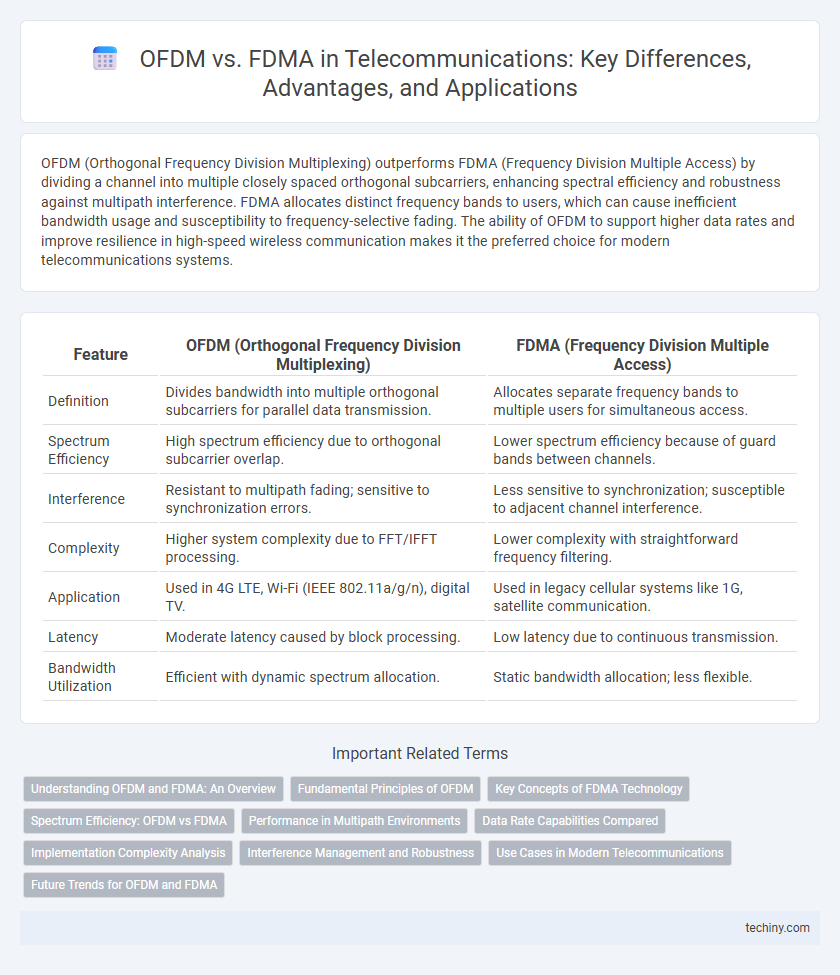OFDM (Orthogonal Frequency Division Multiplexing) outperforms FDMA (Frequency Division Multiple Access) by dividing a channel into multiple closely spaced orthogonal subcarriers, enhancing spectral efficiency and robustness against multipath interference. FDMA allocates distinct frequency bands to users, which can cause inefficient bandwidth usage and susceptibility to frequency-selective fading. The ability of OFDM to support higher data rates and improve resilience in high-speed wireless communication makes it the preferred choice for modern telecommunications systems.
Table of Comparison
| Feature | OFDM (Orthogonal Frequency Division Multiplexing) | FDMA (Frequency Division Multiple Access) |
|---|---|---|
| Definition | Divides bandwidth into multiple orthogonal subcarriers for parallel data transmission. | Allocates separate frequency bands to multiple users for simultaneous access. |
| Spectrum Efficiency | High spectrum efficiency due to orthogonal subcarrier overlap. | Lower spectrum efficiency because of guard bands between channels. |
| Interference | Resistant to multipath fading; sensitive to synchronization errors. | Less sensitive to synchronization; susceptible to adjacent channel interference. |
| Complexity | Higher system complexity due to FFT/IFFT processing. | Lower complexity with straightforward frequency filtering. |
| Application | Used in 4G LTE, Wi-Fi (IEEE 802.11a/g/n), digital TV. | Used in legacy cellular systems like 1G, satellite communication. |
| Latency | Moderate latency caused by block processing. | Low latency due to continuous transmission. |
| Bandwidth Utilization | Efficient with dynamic spectrum allocation. | Static bandwidth allocation; less flexible. |
Understanding OFDM and FDMA: An Overview
Orthogonal Frequency Division Multiplexing (OFDM) divides a communication channel into multiple orthogonal subcarriers, allowing simultaneous data transmission with high spectral efficiency and resistance to multipath fading. Frequency Division Multiple Access (FDMA) allocates distinct frequency bands to individual users, providing straightforward channel separation but with less efficient bandwidth utilization compared to OFDM. OFDM's robustness in high-data-rate applications and FDMA's simplicity highlight their distinct roles in modern wireless telecommunications.
Fundamental Principles of OFDM
Orthogonal Frequency Division Multiplexing (OFDM) divides the available spectrum into multiple orthogonal sub-carriers, enabling simultaneous data transmission and reducing inter-symbol interference. Unlike Frequency Division Multiple Access (FDMA), which allocates distinct frequency bands to users, OFDM employs overlapping sub-carriers with precise frequency spacing to maximize spectral efficiency. The fundamental principle of OFDM relies on maintaining orthogonality between sub-carriers, which allows for robust performance in multipath fading environments and efficient utilization of bandwidth.
Key Concepts of FDMA Technology
FDMA (Frequency Division Multiple Access) allocates unique frequency bands to individual users, allowing simultaneous transmissions without interference. This technology relies on fixed bandwidth channels separated by guard bands to minimize cross-channel interference in telecommunications networks. FDMA's simplicity and continuous channel allocation make it ideal for analog systems and specific digital communication scenarios.
Spectrum Efficiency: OFDM vs FDMA
OFDM (Orthogonal Frequency Division Multiplexing) offers superior spectrum efficiency compared to FDMA (Frequency Division Multiple Access) by dividing the available bandwidth into numerous orthogonal subcarriers, minimizing guard bands and enabling denser channel packing. FDMA allocates distinct frequency bands to users with guard bands to prevent interference, resulting in underutilized spectrum and lower channel density. The orthogonality in OFDM allows simultaneous transmission over closely spaced frequencies, maximizing data throughput within limited bandwidth.
Performance in Multipath Environments
OFDM (Orthogonal Frequency Division Multiplexing) significantly outperforms FDMA (Frequency Division Multiple Access) in multipath environments due to its inherent resistance to inter-symbol interference through the use of multiple orthogonal subcarriers and cyclic prefix. The parallel subcarrier structure of OFDM enables robust signal detection despite delay spread and frequency-selective fading, resulting in higher spectral efficiency and better bit error rates compared to FDMA. FDMA's continuous single-carrier transmission is more susceptible to multipath-induced fading and requires complex equalization techniques, which limits its performance in channels with severe multipath propagation.
Data Rate Capabilities Compared
OFDM (Orthogonal Frequency Division Multiplexing) supports higher data rates by dividing the available bandwidth into multiple orthogonal subcarriers, enabling parallel data transmission and efficient spectrum utilization. In contrast, FDMA (Frequency Division Multiple Access) allocates distinct frequency bands to each user, which limits data rate scalability due to fixed bandwidth segments and guard bands. OFDM's ability to mitigate inter-symbol interference and adapt to channel conditions results in significantly improved throughput compared to FDMA in modern telecommunications networks.
Implementation Complexity Analysis
Orthogonal Frequency Division Multiplexing (OFDM) presents higher implementation complexity compared to Frequency Division Multiple Access (FDMA) due to its reliance on Fast Fourier Transform (FFT) algorithms for signal modulation and demodulation. OFDM requires sophisticated frequency synchronization and channel estimation to manage inter-symbol interference and multipath fading, increasing computational overhead. In contrast, FDMA allocates fixed frequency bands to users, simplifying hardware design and reducing signal processing demands.
Interference Management and Robustness
Orthogonal Frequency Division Multiplexing (OFDM) effectively manages interference by dividing the spectrum into orthogonal subcarriers, minimizing inter-carrier interference and improving robustness against multipath fading in high-density environments. Frequency Division Multiple Access (FDMA) allocates distinct frequency bands to users, reducing co-channel interference but being less flexible in handling dynamic spectrum usage and multipath disturbances. OFDM's inherent resistance to frequency-selective fading and efficient interference mitigation make it superior in complex, interference-prone telecommunications scenarios compared to FDMA.
Use Cases in Modern Telecommunications
OFDM (Orthogonal Frequency Division Multiplexing) excels in high-speed broadband applications such as 4G LTE and 5G NR due to its robustness against multipath fading and spectral efficiency. FDMA (Frequency Division Multiple Access) remains relevant in legacy systems and low-data-rate services like traditional satellite communication and certain IoT networks. Modern telecommunications increasingly favor OFDM for mobile networks and Wi-Fi because it supports higher data rates and flexible spectrum allocation compared to FDMA.
Future Trends for OFDM and FDMA
Future trends in OFDM emphasize its adaptability for 5G and beyond, leveraging advanced MIMO techniques and dynamic spectrum allocation to enhance spectral efficiency and minimize interference. FDMA, while less flexible, remains relevant in narrowband IoT and legacy systems due to its simplicity and low power consumption. Emerging hybrid access schemes combining OFDM's high data rates with FDMA's reliability are gaining traction for next-generation wireless networks.
OFDM vs FDMA Infographic

 techiny.com
techiny.com